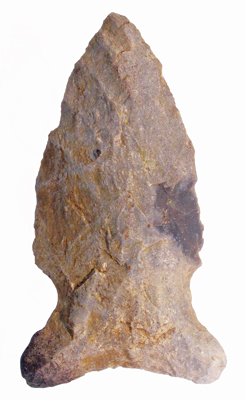

Point Type: ROWAN
Also See: Big Sandy, Bolen, Brewerton Side Notched, Dalton-Meserve,
Dalton-Greenbrier, Halifax, Hardaway, Taylor, Quad
Location: Far Eastern United
States
Associated Dates: 9,500 -
8,500 B.P. - Early Archaic
Morphology: Auriculate
General
Description: The Rowan point is a small to medium sized dart point with wide side notches and a straight to concave base
. Notches are large and ground on both faces. The base is also
ground. In some examples, the notches are
extremely elongated and shallow with slight shoulders and prominent tangs
or ears / auricles.
The blade edges are
straight or convex and sometimes serrated. The distal tip is acute or pointed. Nearly all examples have
a flaked bevel on at least one blade edge. Some
specimens are flattened
with a flaked bevel on three or four edges. In addition to
ground notches and base, the tangs are always thoroughly ground and rounded or
somewhat pointed. Most tangs and tips are quite thin. Many examples
are lightly ground over the entire hafting area on one or both
faces.
Rowan points are made by random percussion flaking with secondary retouch. Beveled blade edges are steep
or shallow and are often made by fairly good parallel oblique flaking over random
flaking. Bases are thinned by removal
of several vertical parallel or random flakes followed by grinding which
obliterates some or all of the signs of flaking. Notches are formed by
removal of several percussion flakes
followed by grinding that
leaves few flake scars.
The Rowan point ranges from 38 mm to 55 mm in
length. The width at the shoulders ranges from 20 mm to 30 mm. The
basal tangs range from 23 mm to 33 mm wide. The notched stem ranges from
13 mm to 25 mm in width. Notches range from 9 mm to 15 mm long and 2.5 to
8 mm deep. The distal tip is thin 2 - 3 mm as are the tips of the
tangs.
The Rowan point is usually
made from chert, rhyolite, silicified shale
and quartzite
.
The Rowan point type has been found in North
Carolina, South Carolina, Virginia, Georgia and Florida. According to site
reports, similar points have been found in other southeastern states and even
into the Ohio River Valley.
The Rowan
point type has not been formally dated but they have been found in one poorly stratified
site associated with the
Kirk Corner Notched, Lost Lake, Big Sandy type I and Palmer points. In
another poorly stratified site they were also associated with the Palmer, Quad
and Hardaway Side Notched types.
On
the basis of morphology , technology,
and provenance, the Rowan points are assigned to the Early Archaic with an
estimated date of 9,500 - 8,500 B.P. and may continue forward into the Middle
Archaic period.
It is believed
that the Rowan point type is technologically related to the transition
stage of the Dalton-Meserve, Quad and
Hardaway forms and into the Early Archaic corner-notched and side-notched
forms. Like any transition form of point, the Rowan possess features of
antecedents and decedents.
Joffre Laning Coe's Halifax point type
(1964, The Formative Cultures of the Carolina Piedmont, Transactions of the
American Philosophical Society, Vol 54, Part 5, Philadelphia) seems to be
related to the Rowan but appears much later in the Middle Archaic
period.
The Rowan point type was named and described by Peter P. Cooper
II for examples he found in Rowan County, North Carolina and published in the
Central States Archaeological Journal, Vol. 17, No. 3.
About the Point Above: The Rowan point pictured at the top of this page, was found Durham County North Carolina. It is made from light gray black blotched shale with some very small quartz inclusions. Overall, the point measures 45 mm in length, is 25.8 mm wide (across the ears or auricles) and is 10.7 mm thick in mid blade. The concavity of the base measures 2.5 mm deep. The stem measured from the shoulders is 14.5 mm long. The stem is 16.6 mm wide at the notches. The notches are 15.2 mm long. The tips of the ears thin down to 1.3 mm thick and the distal tip is 2.1 mm thick. The base is quite heavily ground as are the ears and the notches pretty much obliterating all flaking scars. There is some fine parallel oblique flaking on the left side of the blade edge. Only one side of the blade (not shown) has a steep bevel. Overall this a fine example of the type in typical material even though it has suffered a few dings and knocks over the many years. The Rowan type appears to be quite rare. Catalog Number 187-12-C
References: Hranicky (1, 2), Overstreet, Peck, Perino (1, 4)
© Copyright 1997 - 2008 LITHICS-Net WWW.LITHICSNET.COM
Use Your Browser's BACK Button to Return to the LITHICS-Net Index.